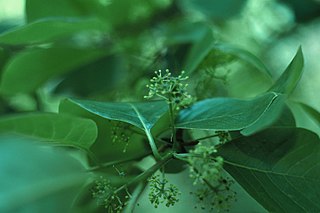
Tupelo, genus Nyssa, is a small genus of deciduous trees with alternate, simple leaves. It is sometimes included in the subfamily Nyssoideae of the dogwood family, Cornaceae, but is placed by other authorities in the family Nyssaceae. In the APG IV system, it is placed in Nyssaceae.

Taxus is a genus of coniferous trees or shrubs known as yews in the family Taxaceae. Yews occur around the globe in temperate zones of the northern hemisphere, northernmost in Norway and southernmost in the South Celebes. Some populations exist in tropical highlands.
Cypress is a common name for various coniferous trees or shrubs of northern temperate regions that belong to the family Cupressaceae. The word cypress is derived from Old French cipres, which was imported from Latin cypressus, the latinisation of the Greek κυπάρισσος (kyparissos). Cypress trees are a large classification of conifers, encompassing the trees and shrubs from the cypress family (Cupressaceae) and many others with the word cypress in their common name. Many cypress trees have needle-like, evergreen foliage and acorn-like seed cones.

Wollemia is a genus of coniferous trees in the family Araucariaceae, endemic to Australia. It represents only one of three living genera in the family, alongside Araucaria and Agathis. The genus only has a single known species, Wollemia nobilis, which was discovered in 1994 in a temperate rainforest wilderness area of the Wollemi National Park in New South Wales. It was growing in a remote series of narrow, steep-sided, sandstone gorges 150 km (93 mi) north-west of Sydney. The genus is named after the National Park.

A threatened species is any species which is vulnerable to extinction in the near future. Species that are threatened are sometimes characterised by the population dynamics measure of critical depensation, a mathematical measure of biomass related to population growth rate. This quantitative metric is one method of evaluating the degree of endangerment without direct reference to human activity.

Glyptostrobus pensilis, known in Chinese as 水松, and also Chinese swamp cypress, is an endangered conifer, and the sole living species in the genus Glyptostrobus.

Malus sieversii is a wild apple native to the mountains of Central Asia in southern Kazakhstan. It has recently been shown to be the primary ancestor of most cultivars of the domesticated apple. It was first described as Pyrus sieversii due to its similarities with pears in 1833 by Carl Friedrich von Ledebour, a German naturalist who saw them growing in the Altai Mountains.
Ormosia howii, the Hainan ormosia, is a species of flowering plant in the family Fabaceae native to southern China. It was initially found on Diaoluo Shan, Hainan Island in 1954 and then in Yangchun, Guangdong in 1957, both times in extremely small populations. The species is now apparently extinct. It was a small tree, 10 metres (33 ft) high, growing in open forests on mountain slopes.
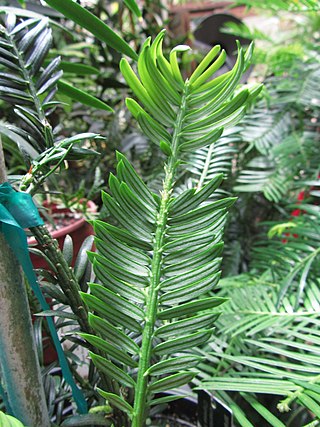
Amentotaxus argotaenia, the catkin yew, is a species of conifer in the family Taxaceae. It is a shrub or a small tree up to 7 metres (23 ft) tall.
Myristica yunnanensis is a species of plant in the family Myristicaceae. It is found in southern Yunnan, China, northern Thailand, and in Thanh Hóa Province, Vietnam. It is a large, evergreen tree, up to 30 m (98 ft) tall.

The flora of China consists of a diverse range of plant species including over 39,000 vascular plants, 27,000 species of fungi and 3000 species of bryophytes. More than 30,000 plant species are native to China, representing nearly one-eighth of the world's total plant species, including thousands found nowhere else on Earth. China's land, extending over 9.6 million km, contains a variety of ecosystems and climates for plants to grow in. Some of the main climates include shores, tropical and subtropical forests, deserts, elevated plateaus and mountains. The events of the continental drift and early Paleozoic Caledonian movement also play a part in creating climatic and geographical diversity resulting in high levels of endemic vascular flora. These landscapes provide different ecosystems and climates for plants to grow in, creating a wide variety of different flora spanning over not just China, but different parts of the world.
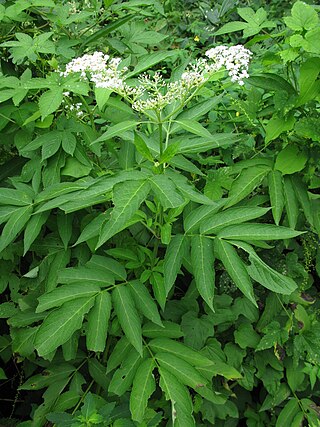
Sambucus javanica, the Chinese elder, is a species of elderberry in the family Viburnaceae native to subtropical and tropical Asia. It is found naturally in Bhutan, Burma, Cambodia, China, India, Indonesia, Japan, Laos, Malaysia, the Philippines, southern Thailand, and Vietnam. It is a perennial herb or a small shrub 1–2 m tall.

Nyssa sinensis is a species of flowering plant in the family Cornaceae, native to China and Vietnam. Growing to 10 m (33 ft) tall and wide, it is a broadly conical deciduous tree, with oval leaves 15–20 cm (6–8 in) long, which turn brilliant red, orange and yellow in autumn.

Acer pentaphyllum is a very rare, endangered maple species endemic to southwestern Sichuan in China, at altitudes of 2300–2900 meters.
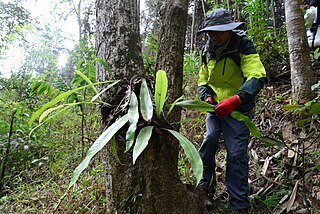
Founded in 2002, Ruili Botanical Garden and Nanmaohu Park is a botanical garden in Ruili. Located 6 km from the city in Dehong Dai and Jingpo Autonomous Prefecture of Yunnan in the South-West of China near the Myanmar border. The park has more than 5,000 acres of well-preserved native vegetation, mainly monsoon evergreen broad-leaved forest, with more than 1,200 species of tropical and subtropical plants.
Genome sequencing of endangered species is the application of Next Generation Sequencing (NGS) technologies in the field of conservation biology, with the aim of generating life history, demographic and phylogenetic data of relevance to the management of endangered wildlife.
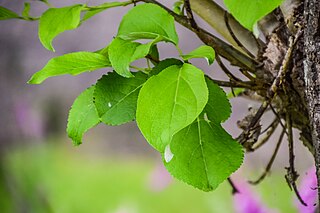
Populus suaveolens, called the Mongolian poplar, Korean poplar and Japanese poplar, is a species of flowering plant in the genus Populus, native to all of northern Asia, the Korean peninsula, the Kurils, and northern Japan. It is a tree reaching 30 m.

Phalaenopsis zhejiangensis, also known as 象鼻兰 in Chinese, is a species of orchid native to Thailand and Vietnam. It is firmly established to be within the genus Phalaenopsis. Its extraordinary flowers are white with purple transverse bands on sepals and petals and with purple lip markings. It is a typical epiphytic orchid. It is found at elevations of 300 to 900 m. The specific epithet zhejiangensis refers to this species origin in the Chinese province of Zhejiang. It is closely related to Phalaenopsis wilsonii.

Schima superba is a species of flowering plant in the tea family Theaceae, native to subtropical areas of Vietnam, southern China, Hainan, Taiwan, and the Ryukyu Islands. With Pinus massoniana it often dominates forests from 100 to 800 m in elevation. It is used as a street tree in a number of southern Chinese cities.
















